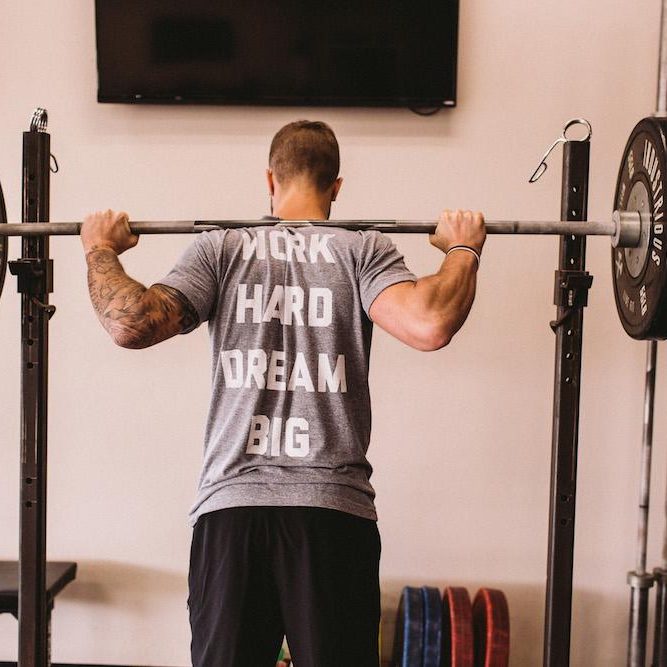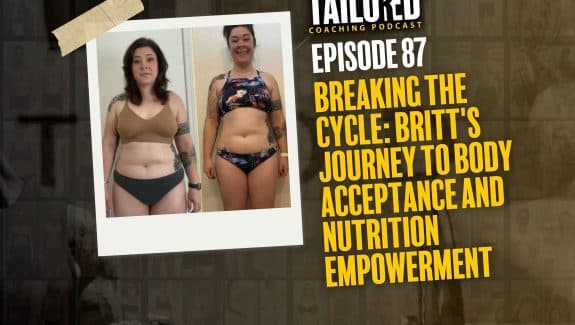 Anyone who is into bodybuilding, or even just training for specific goals and results, knows that one of the biggest factors in the process is progressive overload.
Anyone who is into bodybuilding, or even just training for specific goals and results, knows that one of the biggest factors in the process is progressive overload.
Progressive overload is simply getting a little bit better each time you train.
But are you really doing that? How do you know? And if you are and do know, are you doing it correctly?
The majority of the people that hire me for coaching simply just do not know, and believe me – I’ve been there! I remember walking into LA Fitness aimlessly every day thinking, “I’m just gonna murder my chest and triceps today!”
The issues with that approach to training are endless and I would have to write 27 articles to break them all down, so I’ll save that for later…
For now, lets talk about what you’re doing now and what you should be doing on your next session, next week, and the next months, to make sure you’re on the right track to getting results.
Another big question to ask yourself at this point is – do you know what you’re doing next week? Or how your program will progress and change into the next month/phase?
See this is one of the biggest benefits, from a training perspective, of being in a Coaching Program. Your coach and the program you’re following has a system, phases, or cycles of what you’ll be training, how hard you’ll be training it, how much volume to train it, and how it will progress over the next ____ weeks.
In fact, it’s so important to have an outside expertise and perspective on this that even I, a highly qualified coach, went and hired a coach. I hired 3DMJ (3D Muscle Journey – Natural Bodybuilding/Powerlifting) to program my nutrition and training for the next 12 weeks.
The point is, most of us get stuck just going through the motions or going into the gym with the attitude of, “I just need to get a sweat on”. When in reality sweat has zero correlation of long-term results, nor does the next day’s muscle soreness or burning out during a training session.
And then there is the meatheads like myself who would constantly think, “Every single week I need to add 10lbs to the bar”
Well if that was true, I’d be benching 900lbs by now for reps. But that’s obvious and I think we all understand that. What most of us don’t understand, though, is what other options do we have? How else do we progress? And when we do progress, what is a systematic approach to doing so?
[Again, this is one of the big reasons having a coach is a great thing because my coach outlines exactly how much weight is next week, how many reps I need to do, etc. Click HERE to apply for my Coaching, where I will take out your guesswork.]
There are multiple ways to systemize your approach to how you’re progressing, but step number one is making a point to do so and that is how I would look at the beginners approach to progressive overload.
This form of progressing is meant for those who are just beginning, don’t have the desire to geek out on their programming, or simply do not have an extremely serious body composition goal of fat loss, hypertrophy or gaining serious strength.
For these people, the easiest and best route is to simply record what you do each week and just focus on getting a little better at it. This could mean adding a rep or adding weight, and then after a given phase, adding a set – whatever seems to be the most appropriate or achievable. Sometimes you just cannot go heavier, so add a rep. Maybe you add a rep for 3 weeks in a row, go back to the beginning rep scheme and add an extra set. As long as you focus on getting a little better, you’re in a good place.
Now, when we get serious and geeky with all this… There are two main styles that I suggest and they are slightly different when the goal is strength or hypertrophy. They’re called “Undulating Periodization” and “Block Periodization”.
[There are TONS of other styles as well, but these are ones I prefer because they are easy to implement and understand when it comes to simple progressions.]
Lets start with Undulating Periodization.
We’ll use one exercise, the bench press, for an easier explanation. So for strength and power focused days/programs, it looks something like this:
| Week 1 Bench Press – 100lbs x 5, 5, 5 |
| Week 2 Bench Press – 105lbs x 4, 4, 4 |
| Week 3 Bench Press – 110lbs x 3, 3, 3 |
| Week 4 Bench Press – 105lbs x 5, 5, 5 |
| Week 5 Bench Press – 110lbs x 4, 4, 4 |
| Week 6 Bench Press – 115lbs x 3, 3, 3 |
| Week 7 Bench Press – 110lbs x 5, 5, 5 |
| Week 8 Bench Press – 115lbs x 4, 4, 4 |
| Week 9 Bench Press – 120lbs x 3, 3, 3 |
| Week 10 – 12 – Deload / Taper |
As you can see, every week we add 5lbs to the bar and drop a rep. Then after 3 weeks of this, we drop back a week’s load and go back to the initial rep of 5. So essentially we’ve increased our 5-rep strength, and total overall power/strength, and if we continue to do this we make steady strength gains on a regular basis.
[Don’t forget that if your only interest is building muscle and/or burning fat, we still need to incorporate things to get stronger. It’ll allows us to use heavier weight in the future, when training for body composition, producing better results because of it.]
Some may ask, “Why not 10lbs a week if we can?”
I would say that it could be done that way, especially with beginners. But if we are looking at specifically bringing up strength in one lift over the long haul, it’s best to make small increments and leave 1-2 reps in the tank at each set.
See, going to max or failure brings us to fatigue faster and after that bench press I can guarantee you still have more exercises to perform – you’ll be able to lift more on those lifts and build more muscle and strength by being able to do more in the lifts after that bench press.
Now, lets looks at undulating periodization for hypertrophy (Muscle gain):
| Week 1 – One Arm Rows – 50lbs x 12, 12, 12 |
| Week 2 – One Arm Rows – 55lbs x 10, 10, 10 |
| Week 3 – One Arm Rows – 60lbs x 8, 8, 8 |
| Week 4 – One Arm Rows – 55lbs x 12, 12, 12 |
| Week 5 – One Arm Rows – 60lbs x 10, 10, 10 |
| Week 6 – One Arm Rows – 65lbs x 8, 8, 8 |
| Week 7 – One Arm Rows – 60lbs x 12, 12, 12 |
| Week 8 – One Arm Rows – 65lbs x 10, 10, 10 |
| Week 9 – One Arm Rows – 70lbs x 8, 8, 8 |
| Week 10 – 12 – Deload / Taper |
So similar to the above, we’re dropping reps as we go and adding weight. Only difference is that the reps are set at a higher point and drop in bigger increments. But same exact strategy, applied to hypertrophy.
Now, someone like me who does an “Upper Lower Split” (1 heavy upper and lower day and 1 hypertrophy upper and lower day per week) would utilize the power/strength undulating progression scheme on my heavy days and the hypertrophy undulating scheme above on my higher rep days.
Someone who focuses solely on one style of training or goal would simply use one of these templates.
Someone who combines each style in every workout, say someone who does 2-3 full body strength training sessions per week, would simply apply the first template to their big lift(s) at the beginning of their workout (bench, squat, deadlift) and the later template to the accessory work they do later in the workout (lunges, rows, curls, etc.). For someone looking for fat loss specifically, that is what I recommend doing during his or her strength training workouts.
Next, we have block periodization.
This style is a little easier to track and in my experience calls for a deload week a little more frequently, where as the undulating style has a somewhat built in deload as you progress – being that you reduce reps as the weight increases.
Either way, deload weeks are necessary to add in and can be done anywhere between every 4 weeks all the way to 12 weeks. May seem like a huge gap, and it is, but that is because there should never be a “rule” or set in stone time for a deload. It is much more so about listening to your body and being aware of when it is time to take it down a notch.
So lets take a look at some examples of block periodization:
| Strength/Power Phase |
| Week 1 – Bench Press – 100lbs x 5,5,5,5 |
| Week 2 – Bench Press – 105lbs x 5,5,5,5 |
| Week 3 – Bench Press – 110lbs x 5,5,5,5 |
| Week 4 – Bench Press – 115lbs x 5,5,5,5 |
| Week 5 – Bench Press – 115-120lbs x5,5,5 (Deload, Reduce Total Volume via Sets on big lifts.) |
So with block periodization and strength/power training, it is fairly simple to plan out your training progressions. You simply add weight to the bar each week and maintain the reps/sets given. After 4 weeks, you deload your training by reducing total volume via sets while still progressing load or staying at the load lifted the week prior (really depends on personal fatigue/feeling).
And after that week, you add the set back in at the same load or an extra 5lbs in the new cycle. But at the end of the day it is simply just adding weight to the bar, but like I said before – we cannot do this forever. Which is why it is best to be conservative in my opinion. We will get better strength gains in the long run by adding the weight slowly and with small increments each week, rather than jumping the gun to add 20lbs to the bar next week.
You will also want to plan out the phase that follows, meaning using a different variation, movement, or slightly changing rep/sets by 1-3. This will get us away from the hopes and dreams of adding 5lbs to the bar for eternity and becoming the strongest man alive.
One very important thing to remember is being aware of your body and how you’re feeling in the gym that day. If you slept like shit, have a nagging muscle or joint, or simply just aren’t “in it” – then back off. You don’t NEED to jump 5lbs per week, so either stay at the load and a rep or simply do not change a thing.
And then we have block periodization for hypertrophy training:
| Hypertrophy Phase |
| Week 1 – One Arm Rows – 50lbs x 8,8,8 |
| Week 2 – One Arm Rows – 50lbs x 9,9,9 |
| Week 3 – One Arm Rows – 50lbs x 10,10,10 |
| Week 4 – One Arm Rows – 50lbs x 11,11,11 |
| Week 5 – One Arm Rows – 50lbs x 12,12,12 |
| Week 6 (new cycle) – One Arm Rows – 55lbs x8,8,8 |
Just as easy and very similar to the strength block periodization, you simply add a rep each week while maintaining the load/weight. Being that hypertrophy is generally 8-12 reps, as you can see above, we added a rep each week until we hit 12 reps and then jumped back down to 8 at a heavier weight.
You’re not limited to the 8-12 rep ranges, but for the main lifts it works best as you will be able to use a decent load while training and that is a big factor for growth. I will implement this strategy to higher reps, 12-15, with smaller lifts like curls, lateral raises, some presses, and row variations – starting at 12 reps and progressing to 15 reps by the end of the 4 week cycle.
You can also set it up in 3 week cycle’s with the 4th week being a deload week. During this, you could add 2 reps per week – going from 8 to 10 to 12 and then deloading by removing 1-2 sets of the bigger exercises while staying in the 12 rep range.
With all this, the key is to not let it confuse you and simply focus on the best and least stressful way for you to implement your progression scheme. Because we all know, as it’s been proven over and over again, we need to slowly progress overtime to see the results we want to see – whether that is gaining strength, losing body fat, or building serious size.
When it comes to my own personal training and program, I use more of a block periodization because it’s easier for me to track and seems to fit my programming at the moment a little better (and because my coach suggested it for me).
But at the end of the day, or I guess I should say this article, my point for you to take home is to simply track your workouts and be sure you’re progressing.
Progressing week after week, no matter which way you do so, will be the biggest factor in achieving results.
If you feel like this is lacking in your training or that this could possibly be a huge factor holding you back from breaking the plateau you’re in and seeing great results,
– (This is exactly what held me back. But once I implemented this, everything changed) –
Then click the link below and get on a Free Discover Call with me where I can show you how we can change that, for you.























































































































































































































































































































































































































































































